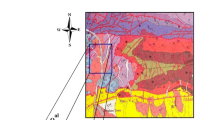Abstract
Pyrite oxidation and release of the oxidation products from a low-grade coal waste dump to stream, groundwater and soil was investigated by geochemical and hydrogeochemical techniques at Alborz Sharghi coal washing plant, Shahrood, northeast Iran. Hydrogeochemical analysis of water samples indicates that the metal concentrations in the stream waters were low. Moreover, the pH of the water showed no considerable change. The analysis of the stream water samples shows that except the physical changes, pyrite oxidation process within the coal washing waste dump has not affected the quality of the stream water. Water type was determined to be calcium sulphate. The results of the analysis of groundwater samples indicate that the pH varies from 7.41 to 7.51. The concentrations of the toxic metals were low. The concentration of SO4 is slightly above than its standard concentration in potable water. It seems that the groundwater less affected by the coal washing operation in the study area. Geochemical analysis of the sediment samples shows that Fe concentration decreases gradually downstream the waste dump with pH rising. SO4 decreases rapidly downstream direction. Copper, Zn and Co concentrations decrease with distance from the waste dump due to a dilution effect by the mixing of uncontaminated sediments. These elements, in particular, Zn are considerably elevated in sediment sample collected at the nearest distance to the waste dump. There is no doubt that such investigations can help to develop an appropriate water remediation plan.
Similar content being viewed by others
References
Alborz Sharghi Coal Company (1981). Detailed explorations of the Razmjah coal area. Technical report, pp. 1–50.
Atkins, A. S., & Pooley, F. D. (1982). The effects of bio-mechanisms on acidic mine drainage in coal mining. International Journal of Mine Water, 1, 31–44.
Banks, S. B., & Banks, D. (2001). Abandoned mines drainage: Impact assessment and mitigation of discharges from coal mines in the UK. Engineering Geologist, 60, 31–37.
Banks, D., Burke, S. P., & Gray, C. G. (1997). The hydrogeochemistry of coal mine drainage and other ferruginous waters in North Derbyshire and South Yorkshire, UK. Quarterly Journal of Engineering Geology, 30, 257–280.
Benjamin, M. M. (1983). Adsorption and surface precipitation of metals of amorphous iron oxyhydroxide. Environmental Science & Technology, 17, 686–692.
Canovas, C. R., Olias, M., Nieto, J. M., Sarmiento, A. M., & Ceron, J. C. (2007). Hydrogeochemical characteristics of the Tinto and Odiel Rivers (SW Spain). Factors controlling metal contents. Science of the Total Environment, 373, 363–382.
Doulati Ardejani, F., Jodieri Shokri, B., Moradzadeh, A., Soleimani, E., & Ansari Jafari, M. (2008). A combined mathematical–geophysical model for prediction of pyrite oxidation and pollutant leaching associated with a coal washing waste dump. International Journal of Environmental Sciences & Techniques, 5(4), 517–526.
Doulati Ardejani, F., Jodieri Shokri, B., Bagheri, M., & Soleimani, E. (2010). Investigation of pyrite oxidation and acid mine drainage characterization associated with Razi active coal mine and coal washing waste dumps in the Azad Shahr–Ramian region, northeast Iran. Environmental Earth Science, 61, 1547–1560.
Erickson, P. M., Kleinmann, R. L. P., Posluszny, E. T., & Leonard-Mayer, P. J. (1982). Hydrogeochemistry of a large mine pool. In Proceedings of the 1st Intl. Mine Water Congress of the Intl. Mine Water Association (IMWA), April 19–24, 1982. Budapest, Hungary, pp. 27–42.
European Communities Regulations (1989). Quality of surface water intended for the abstraction of drinking water. S.I. No. 294/1989.
Iran Meteorological Organisation (2006). Iranian climate normals, 1996–2006, Iranian Climate Institute. Accessible at http://www.irimo.ir/english/statistics/index.asp.
Kim, J. Y., & Chon, H. T. (2001). Pollution of a water course impacted by acid mine drainage in the Imgok creek of the Gangreung coal field, Korea. Applied Geochemistry, 16, 1387–1396.
Lee, J. S., & Chon, H. T. (2006). Hydrogeochemical characteristics of acid mine drainage in the vicinity of an abandoned mine, Daduk Creek, Korea. Journal of Geochemical Exploration, 88, 37–40.
Moncur, M. C., Ptacek, C. J., Blowes, D. W., & Jambor, J. L. (2005). Release, transport and attenuation of metals from an old tailings impoundment. Applied Geochemistry, 20, 639–659.
Osanlo, M. (1999). Coal engineering. Naghous Publications, first volume, p. 320.
Patankar, S. (1980). Numerical heat transfer and fluid flow (1st. ed., p. 197). USA: Taylor & Francis.
Sawyer, C. N., McCarty, P. L., & Parkin, G. F. (2003). Chemistry for environmental engineering and science, (5th ed.). New York: McGraw-Hill.
Singh, R. N. (1998). Mine water (p. 290). Wollongong: Wollongong University Press.
Spalding, D. B. (1981). A general purpose computer program for multi-dimensional one- and two-phase flow. Mathematics and Computers in Simulation, 23(3), 267–276.
Stiefel, R. C., & Busch, L. L. (1983). Surface water quality monitoring. In: L. V. A. Sendlein, H. Yazicigil, C. L. Carlson (Eds.), Surface mining environmental monitoring and reclamation handbook (pp. 189–212). New York: Elsevier.
Todd, D. K. (1959). Groundwater hydrology (p. 336). New York: Wiley.
WHO (2008). Guidelines for drinking-water quality, (3rd ed., Vol. 1), recommendations, (3rd ed.) incorporating 1st and 2nd addenda. Geneva: WHO.
Wisotzky, F., & Obermann, P. (2001). Acid mine drainage in lignite overburden dumps and its prevention—the Rhineland lignite mining area (Germany). Ecological Engineering, 17, 115–123.
Williams, R. E. (1975). Waste production and disposal in mining, milling, and Metallurgical industries (p. 489). San Francisco: Miller-Freeman.
WPCAMR, Western P A Coalition for Abandoned Mine Reclamation (2011). Circulating fluidized bed (CFB) power plants for burning coal wastes. http://www.amrclearinghouse.org-Sub-landreclamation-cfb-CoalRefuseBurningPowerPlants.pdf.
Zhao, F., Cong, Z., Sun, H., & Ren, D. (2007). The geochemistry of rare earth elements (REE) in acid mine drainage from the Sitai coal mine, Shanxi Province, North China. International Journal of Coal Geology, 70, 184–192.
Author information
Authors and Affiliations
Corresponding author
Rights and permissions
About this article
Cite this article
Doulati Ardejani, F., Jodieri Shokri, B., Moradzadeh, A. et al. Geochemical characterisation of pyrite oxidation and environmental problems related to release and transport of metals from a coal washing low-grade waste dump, Shahrood, northeast Iran. Environ Monit Assess 183, 41–55 (2011). https://doi.org/10.1007/s10661-011-1904-2
Received:
Accepted:
Published:
Issue Date:
DOI: https://doi.org/10.1007/s10661-011-1904-2




